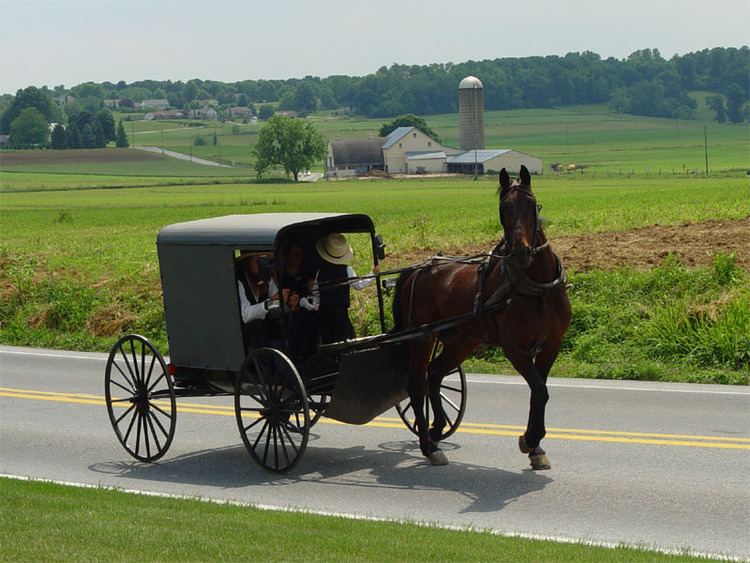 | ||
The Amish (/ˈɑːmɪʃ/; Pennsylvania Dutch: Amisch, German: Amische) are a group of traditionalist Christian church fellowships with Swiss Anabaptist origins. They are closely related to, but distinct from, Mennonite churches. The Amish are known for simple living, plain dress, and reluctance to adopt many conveniences of modern technology. The history of the Amish church began with a schism in Switzerland within a group of Swiss and Alsatian Anabaptists in 1693 led by Jakob Ammann. Those who followed Ammann became known as Amish.
Contents
- History
- Religious practices
- Way of life
- Cuisine
- Subgroups of Amish
- Affiliations
- Use of technology by different Amish affiliations
- Language
- Ethnicity
- Para Amish groups
- Population
- Distribution
- Seekers and joiners
- Health
- Amish life in the modern world
- Publishing
- Similar groups
- Native American Reconciliation
- References

In the early 18th century, many Amish and Mennonites emigrated to Pennsylvania for a variety of reasons. Today, the most traditional descendants of the Amish continue to speak Pennsylvania German, also known as "Pennsylvania Dutch", although a dialect of Swiss German is used by Old Order Amish in the Adams County, Indiana area. As of 2000, over 165,000 Old Order Amish lived in the United States and about 1,500 lived in Canada. A 2008 study suggested their numbers had increased to 227,000, and in 2010 a study suggested their population had grown by 10 percent in the past two years to 249,000, with increasing movement to the West. Most of the Amish continue to have 6–7 children while benefiting from the major decrease in infant and maternal mortality in the 20th century. Between 1992 and 2013, the Amish population increased by 120%, while the US population increased by only 23%.
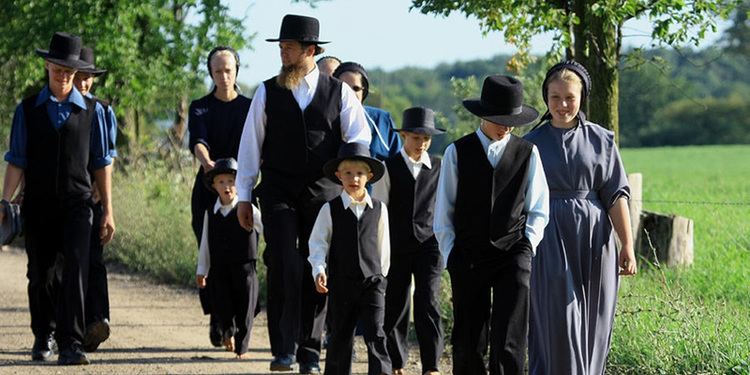
Amish church membership begins with baptism, usually between the ages of 16 and 25. It is a requirement for marriage within the Amish church. Once a person is baptized with the church, he or she may marry only within the faith. Church districts average between 20 and 40 families, and worship services are held every other Sunday in a member's home. The district is led by a bishop and several ministers and deacons. The rules of the church, the Ordnung, must be observed by every member and cover most aspects of day-to-day living, including prohibitions or limitations on the use of power-line electricity, telephones, and automobiles, as well as regulations on clothing. Most Amish do not buy commercial insurance or participate in Social Security. As present-day Anabaptists, Amish church members practice nonresistance and will not perform any type of military service. The Amish value rural life, manual labor and humility, all under the auspices of living what they interpret to be God's word.
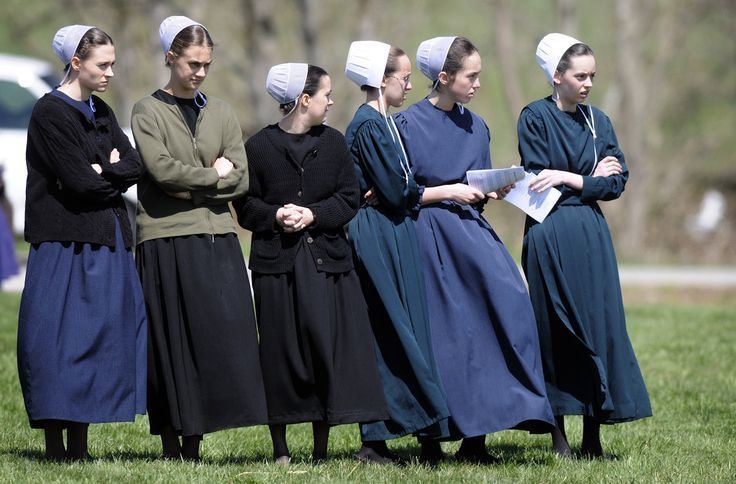
Members who do not conform to these community expectations and who cannot be convinced to repent are excommunicated. In addition to excommunication, members may be shunned, a practice that limits social contacts to shame the wayward member into returning to the church. Almost 90 percent of Amish teenagers choose to be baptized and join the church. During adolescence rumspringa ("running around") in some communities, nonconforming behavior that would result in the shunning of an adult who had made the permanent commitment of baptism, may meet with a degree of forbearance. Amish church groups seek to maintain a degree of separation from the non-Amish world, i.e. American and Canadian society. There is generally a heavy emphasis on church and family relationships. They typically operate their own one-room schools and discontinue formal education after grade eight, at age 13/14. Until the children turn 16, they have vocational training under the tutelage of their parents, community, and the school teacher.
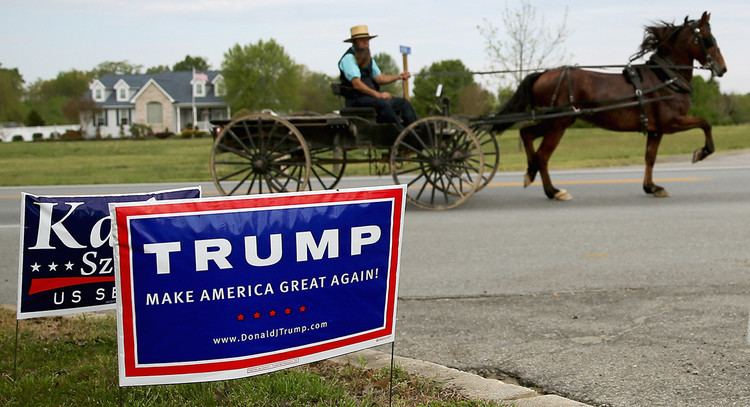
History
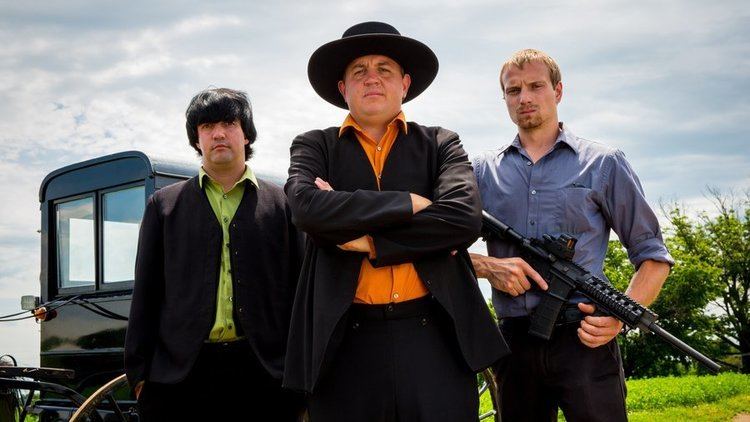
The Amish Mennonite movement descends from the 16th century fellowship known as the Swiss Brethren. The Swiss Brethren were Anabaptists, and are often viewed as having been a part of the Radical Reformation. "Anabaptist" means "one who baptizes again"—a reference to those who had been baptized as infants, but later adopted a belief in "believer's baptism", and then let themselves again be baptized as adults. These Swiss Brethren trace their origins to Felix Manz (c. 1498–1527) and Conrad Grebel (c. 1498–1526), who had broken from reformer Huldrych Zwingli.
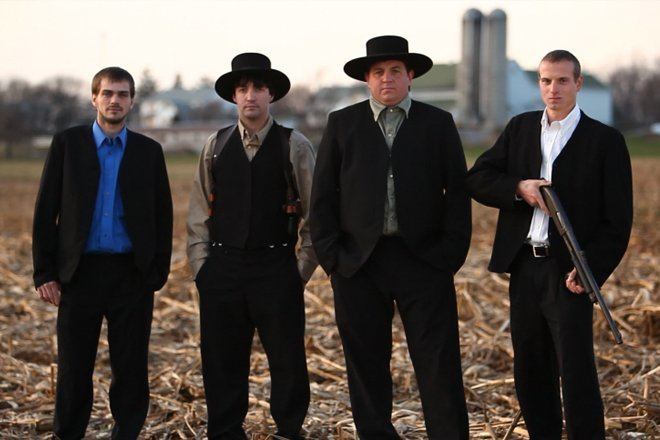
The Swiss Brethren (from which both Amish and Mennonites draw their roots) began in Zürich, Switzerland but were pushed out by Swiss authorities; the turning point of the persecution being the execution of Anabaptist leader Heinrich Frick in the fall of 1635. This pushed the Swiss Brethren into Canton Bern.
The term Amish was first used as a schandename (a term of disgrace) in 1710 by opponents of Jakob Amman. The first division between Swiss Brethren was recorded in the 17th century between Oberländers (those among the hills) and Emmentaler (those living in the Emmental valley). The Oberländers were a more extreme congregation; their zeal pushing them into more remote areas and their solitude making them more zealous.
Swiss Anabaptism developed, from this point, in two parallel streams, most clearly marked by disagreement over the preferred treatment of "fallen" believers. The Emmentalers (sometimes referred to as Reistians, after bishop Hans Reist, a leader among the Emmentalers) argued that fallen believers should only be withheld from communion, and not regular meals. The Amish argued that those who had been banned should be avoided even in common meals. The Reistian side eventually formed the basis of the Swiss Mennonite Conference. Because of this common heritage, Amish and Mennonites from South Germany and Switzerland retain many similarities. Those who leave the Amish fold tend to join various congregations of Conservative Mennonites.
Amish Mennonites began migrating to Pennsylvania, then known for its religious toleration, in the 18th century as part of a larger migration from the Palatinate and neighboring areas. This migration was a reaction to religious wars, poverty, and religious persecution on the Continent. The first Amish immigrants went to Berks County, Pennsylvania, but later moved, motivated by land issues and by security concerns tied to the French and Indian War. Many eventually settled in Lancaster County, Pennsylvania. Other groups later settled elsewhere in North America.
The Amish congregations remaining in Europe slowly merged with the Mennonites. The last Amish congregation to merge was the Ixheim Amish congregation, which merged with the neighboring Mennonite Church in 1937. Some Mennonite congregations, including most in Alsace, are descended directly from former Amish congregations.
Most Amish communities that were established in North America did not ultimately retain their Amish identity. The original major split that resulted in the loss of identity occurred in the 1860s. During that decade Dienerversammlungen (ministerial conferences) were held in Wayne County, Ohio, concerning how the Amish should deal with the pressures of modern society. The meetings themselves were a progressive idea; for bishops to assemble to discuss uniformity was an unprecedented notion in the Amish church. By the first several meetings, the more traditionally minded bishops agreed to boycott the conferences. The more progressive members, comprising approximately two-thirds of the group, retained the name Amish Mennonite. Many of these eventually united with the Mennonite Church, and other Mennonite denominations, especially in the early 20th century. The more traditionally minded groups became known as the Old Order Amish.
Religious practices
Two key concepts for understanding Amish practices are their rejection of Hochmut (pride, arrogance, haughtiness) and the high value they place on Demut (humility) and Gelassenheit (calmness, composure, placidity), often translated as "submission" or "letting-be". Gelassenheit is perhaps better understood as a reluctance to be forward, to be self-promoting, or to assert oneself. The Amish's willingness to submit to the "Will of Jesus", expressed through group norms, is at odds with the individualism so central to the wider American culture. The Amish anti-individualist orientation is the motive for rejecting labor-saving technologies that might make one less dependent on community. Modern innovations like electricity might spark a competition for status goods, or photographs might cultivate personal vanity.
Way of life
Amish lifestyle is regulated by the Ordnung (German, meaning: order), which differs slightly from community to community, and, within a community, from district to district. What is acceptable in one community may not be acceptable in another.
Bearing children, raising them, and socializing with neighbors and relatives are the greatest functions of the Amish family. All Amish believe large families are a blessing from God.
Cuisine
Amish cuisine is noted for its simplicity and traditional qualities. Food plays an important part in Amish social life and is served at potlucks, weddings, fundraisers, farewells and other events. Many Amish foods are sold at markets including pies, preserves, bread mixes, pickled produce, desserts and canned goods. Many Amish communities have also established restaurants for visitors.
Subgroups of Amish
Over the years, the Amish churches have divided many times over doctrinal disputes. The largest group, the "Old Order" Amish, a conservative faction that separated from other Amish in the 1860s, are those that have most emphasized traditional practices and beliefs. The New Order Amish are a group of Amish that some scholars see best described as a subgroup of Old Order Amish, despite the name.
Affiliations
There are eight major affiliations of Old Order Amish with the largest number of districts belonging to Lancaster:
Use of technology by different Amish affiliations
The table below indicates the use of certain technologies by different Amish affiliations. The use of cars is not allowed by any Old and New Order Amish, nor are radio, television or in most cases the use of the Internet. The three affiliations: "Lancaster", "Holmes Old Order" and "Elkhart-LaGrange" are not only the three largest affiliations, they also represent the mainstream among the Old Order Amish. The most conservative affiliations are above, the most modern ones below. Technologies used by very few are on the left; the ones used by most are on the right. The percentage of all Amish who use a technology is also indicated approximately.
* Natural gas allowed
Language
Most Old Order Amish speak Pennsylvania Dutch, and refer to non-Amish people as "English", regardless of ethnicity. Some Amish who migrated to the United States in the 1850s speak a form of Bernese German or a Low Alemannic Alsatian dialect. According to one scholar, "today, almost all Amish are functionally bilingual in Pennsylvania Dutch and English; however, domains of usage are sharply separated. Pennsylvania Dutch dominates in most in-group settings, such as the dinner table and preaching in church services. In contrast, English is used for most reading and writing. English is also the medium of instruction in schools and is used in business transactions and often, out of politeness, in situations involving interactions with non-Amish. Finally, the Amish read prayers and sing in Standard German (which, in Pennsylvania Dutch, is called Hochdeitsch) at church services. The distinctive use of three different languages serves as a powerful conveyor of Amish identity. "Although 'the English language is being used in more and more situations,' Pennsylvania Dutch is 'one of a handful of minority languages in the United States that is neither endangered nor supported by continual arrivals of immigrants.'"
Ethnicity
The Amish largely share a German or Swiss-German ancestry. They generally use the term "Amish" only for members of their faith community and not as an ethnic designation. However some Amish descendants recognize their cultural background knowing their genetic and cultural traits are uniquely different from other ethnicities. Those who choose to affiliate with the church, or young children raised in Amish homes, but too young to yet be church members, are considered to be Amish. Certain Mennonite churches have a high number of people who were formerly from Amish congregations. Although more Amish immigrated to America in the 19th century than during the 18th century, most of today's Amish descend from 18th-century immigrants. The latter tended to emphasize tradition to a greater extent, and were perhaps more likely to maintain a separate Amish identity. There are a number of Amish Mennonite church groups that had never in their history been associated with the Old Order Amish. The former Western Ontario Mennonite Conference (WOMC) was made up almost entirely of former Amish Mennonites who reunited with the Mennonite Church in Canada. Orland Gingerich's book The Amish of Canada devotes the vast majority of its pages not to the Beachy or Old Order Amish, but to congregations in the former WOMC.
Para-Amish groups
There are also several groups, called "para-Amish" by G.C. Waldrep and others, that share many characteristics with the Amish, like horse and buggy transportation, Plain dress and the preservation of the German language. The members of these groups are largely of Amish origin, but these groups are not in fellowship with other Amish groups, because they adhere to theological doctrines (e.g., assurance of salvation) or practices (community of goods) that are normally not accepted among mainstream Amish. A former Amish group is the Bergholz Community.
Population
Because the Amish are usually baptized no earlier than 18 and children are not counted in local congregation numbers, it is hard to estimate their numbers. Rough estimates from various studies placed their numbers at 125,000 in 1992; 166,000 in 2000; and 221,000 in 2008. Thus, from 1992 to 2008, population growth among the Amish in North America was 84 percent (3.6 percent per year). During that time they established 184 new settlements and moved into six new states. In 2000, about 165,620 Old Order Amish resided in the United States, of whom 73,609 were church members. The Amish are among the fastest-growing populations in the world, with an average of seven children per family.
In 2010, a few religious bodies, including the Amish, changed the way their adherents were reported to better match the standards of the Association of Statisticians of American Religious Bodies (ASARB). When looking at all Amish adherents and not solely Old Order Amish, there were about 241,000 Amish adherents in 28 states in 2010.
Distribution
United States
There are Old Order communities in 27 U.S. states. Ohio has the largest population (55,000), followed by Pennsylvania (51,000) and Indiana (38,000). The largest Amish settlements are in Holmes County in northeast Ohio, Lancaster County in south-eastern Pennsylvania, and Elkhart and LaGrange counties in northeast Indiana.
The largest concentration of Amish west of the Mississippi River is in Missouri, with other settlements in eastern Iowa and southeast Minnesota. The largest Amish settlements in Iowa are located near Kalona and Bloomfield. Another major settlement of 10,000 Old Order Amish is also located in west central Wisconsin. Because of rapid population growth in Amish communities, new settlements are formed to obtain enough farmland. Other reasons for new settlements include locating in isolated areas that support their lifestyle, moving to areas with cultures conducive to their way of life, maintaining proximity to family or other Amish groups, and sometimes to resolve church or leadership conflicts.
The table on the right shows the eight states with the largest Amish population in the years 1992, 2001, 2010 and 2015.
Canada
The majority of Old Order settlements in Canada are located in the province of Ontario, namely Oxford (Norwich Township) and Norfolk counties. A small community is also established in Bruce County (Huron-Kinloss Township) near Lucknow.
In 2016, several dozen Old Order Amish families relocated to Kings County in the province of Prince Edward Island as part of a planned, long-term migration. Increasing land prices in Ontario had reportedly limited the ability of members in those communities to purchase new farms. Currently two separate settlements have been established in the vicinity of the town of Montague; one west of the town in the Summerville - New Perth area, and the other northeast of the town in the Dundas - Bridgetown area.
Europe
A small Beachy Amish congregation associated with Weavertown Amish Mennonite Church exists in the Republic of Ireland.
Seekers and joiners
Only a few outsiders have ever joined the Amish. Since 1950 only some 75 people have joined and remained members of the Amish. Since 1990 some twenty people of Russian Mennonite background have joined the Amish in Aylmer, Ontario.
Two whole Christian communities have joined the Amish: The Church at Smyrna, Maine, one of the five Christian Communities of Elmo Stoll after Stoll's death and the Church at Manton, Michigan, which belonged to a community that was founded by Harry Wanner (1935–2012), a minister of Stauffer Old Order Mennonite background. The "Michigan Churches", with which Smyrna and Manton affiliated, are said to be more open to seekers and converts than other Amish churches. Most of the members of these two para-Amish communities originally came from Plain churches, i. e. Old Order Amish, Old Order Mennonite or Old German Baptist Brethren.
More people have tested Amish life for weeks, months or even years but in the end decided not to join. Others remain just close to the Amish and never thought of joining.
Stephen Scott, himself a convert to the Old Order River Brethren, distinguishes four types of seekers:
Health
Amish populations have higher incidences of particular conditions, including dwarfism, Angelman Syndrome, and various metabolic disorders, as well as an unusual distribution of blood types. The Amish represent a collection of different demes or genetically closed communities. Although the Amish do not have higher rates of genetic disorders than the general population, since almost all Amish descend from about 200 18th-century founders, genetic disorders resulting from inbreeding exist in more isolated districts (an example of the founder effect). Some of these disorders are rare or unique, and are serious enough to increase the mortality rate among Amish children. The Amish are aware of the advantages of exogamy, but for religious reasons marry only within their communities. The majority of Amish accept these as "Gottes Wille" (God's will); they reject the use of preventive genetic tests prior to marriage and genetic testing of unborn children to discover genetic disorders. However, Amish are willing to participate in studies of genetic diseases. Their extensive family histories are useful to researchers investigating diseases such as Alzheimer's, Parkinson's, and macular degeneration.
While the Amish are at an increased risk for some genetic disorders, researchers have found their tendency for clean living can lead to better health. Overall cancer rates in the Amish are reduced and tobacco-related cancers in Amish adults are 37 percent and non-tobacco-related cancers are 72 percent of the rate for Ohio adults. The Amish are protected against many types of cancer both through their lifestyle and through genes that may reduce their susceptibility to cancer. Even skin cancer rates are lower for Amish, despite the fact many Amish make their living working outdoors where they are exposed to sunlight. They are typically covered and dressed by wearing wide-brimmed hats and long sleeves which protect their skin.
Treating genetic problems is the mission of Clinic for Special Children in Strasburg, Pennsylvania, which has developed effective treatments for such problems as maple syrup urine disease, a previously fatal disease. The clinic is embraced by most Amish, ending the need for parents to leave the community to receive proper care for their children, an action that might result in shunning. Another clinic is DDC Clinic for Special Needs Children, located in Middlefield, Ohio, for special-needs children with inherited or metabolic disorders. The DDC Clinic provides treatment, research, and educational services to Amish and non-Amish children and their families.
People's Helpers is an Amish-organized network of mental health caregivers who help families dealing with mental illness and recommend professional counselors. Suicide rates for the Amish are about half that of the general population.
The Old Order Amish do not typically carry private commercial health insurance. A handful of American hospitals, starting in the mid-1990s, created special outreach programs to assist the Amish.
Although not forbidden, most Amish do not practice any form of birth control. They are against abortion and also find "artificial insemination, genetics, eugenics, and stem cell research" to be "inconsistent with Amish values and beliefs".
Amish life in the modern world
As time has passed, the Amish have felt pressures from the modern world. Issues such as taxation, education, law and its enforcement, and occasional discrimination and hostility are areas of difficulty.
The Amish way of life in general has increasingly diverged from that of modern society. On occasion, this has resulted in sporadic discrimination and hostility from their neighbors, such as throwing of stones or other objects at Amish horse-drawn carriages on the roads.
The Amish do not usually educate their children past the eighth grade, believing that the basic knowledge offered up to that point is sufficient to prepare one for the Amish lifestyle. Almost no Amish go to high school and college. In many communities, the Amish operate their own schools, which are typically one-room schoolhouses with teachers (usually young unmarried women) from the Amish community. On May 19, 1972, Jonas Yoder and Wallace Miller of the Old Order Amish, and Adin Yutzy of the Conservative Amish Mennonite Church, were each fined $5 for refusing to send their children, aged 14 and 15, to high school. In Wisconsin v. Yoder, the Wisconsin Supreme Court overturned the conviction, and the U.S. Supreme Court affirmed this, finding the benefits of universal education were not sufficient justification to overcome scrutiny under the Free Exercise Clause of the First Amendment.
The Amish are subject to sales and property taxes. As they seldom own motor vehicles, they rarely have occasion to pay motor vehicle registration fees or spend money in the purchase of fuel for vehicles. Under their beliefs and traditions, generally the Amish do not agree with the idea of Social Security benefits and have a religious objection to insurance. On this basis, the United States Internal Revenue Service agreed in 1961 that they did not need to pay Social Security-related taxes. In 1965, this policy was codified into law. Self-employed individuals in certain sects do not pay into nor receive benefits from the United States Social Security system. This exemption applies to a religious group that is conscientiously opposed to accepting benefits of any private or public insurance, provides a reasonable level of living for its dependent members and has existed continuously since December 31, 1950. The U.S. Supreme Court in 1982 clarified that Amish employers are not exempt, but only those Amish individuals who are self-employed.
Publishing
In 1964 Pathway Publishers was founded by two Amish farmers to print more print material about the Amish and Anabaptists in general. It is located in Lagrange, Indiana, and Aylmer, Ontario. Pathway has become the major publisher of Amish material. Pathway publishes a number of school text books, general reading books, and periodicals. There are also a number of private enterprises who publish everything from general reading to reprints of older literature that has been considered of great value to Amish families. Some Amish read the Pennsylvania German newspaper Hiwwe wie Driwwe, and some of them even contribute dialect texts.
Similar groups
Groups that sprang from the same late 19th century Old Order Movement as the Amish share their Pennsylvania German heritage and often still retain similar features in dress. These Old Order groups include different subgroups of Old Order Mennonites, Old Order Schwarzenau Brethren and Old Order River Brethren. Conservative "Russian" Mennonites and Hutterites who also dress plain and speak German dialects emigrated from other European regions at a different time with different German dialects, separate cultures, and related but different religious traditions. Particularly, the Hutterites live communally and are generally accepting of modern technology. Noah Hoover Mennonites are so similar in outward aspects to the Old Order Amish (dress, beards, horse and buggy, extreme restrictions on modern technology, Pennsylvania German language), that they are often perceived as Amish and even called Amish.
The few remaining Plain Quakers are similar in manner and lifestyle, including their attitudes toward war, but are unrelated to the Amish. Early Quakers were influenced, to some degree, by the Anabaptists, and in turn influenced the Amish in colonial Pennsylvania. Most modern Quakers have since abandoned their traditional dress.
Native American Reconciliation
As early as 1809 Amish were farming side by side with Native American farmers in Pennsylvania. According to Cones Kupwah Snowflower, a Shawnee genealogist, the Amish and Quakers were known to incorporate Native Americans into their families to prevent them from ill treatment, especially after the Removal Act of 1832.
Beginning in 2003, Mennonites held a reconciliation meeting with Native Americans, resulting in subsequent meetings asking for forgiveness. The Amish as pacifists did not engage in warfare with Native Americans, nor displaced them directly, but were part of a wave of European immigrants who forced Native Americans westward. “The Lord told me to honor the Native Americans because they’re the gatekeepers of the land,” stated Melvin Lapp who was raised in an Amish family and helped in a gathering between Amish of Lancaster County, Pennsylvania and twelve Native American tribes.
In 2012, The Lancaster Mennonite Historical Society collaborated with the Native American community to construct a replica Iroquois Longhouse.
